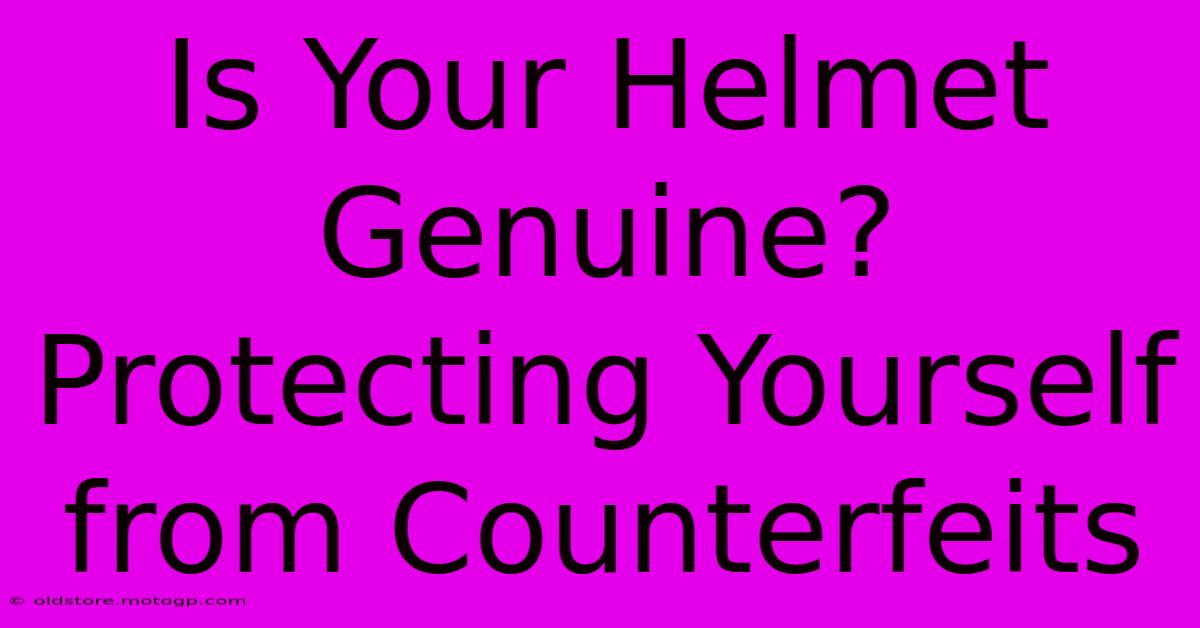Is Your Helmet Genuine? Protecting Yourself From Counterfeits

Table of Contents
Is Your Helmet Genuine? Protecting Yourself from Counterfeit Helmets
Motorcycle helmets are crucial safety equipment, offering vital protection in the event of an accident. But the market is flooded with counterfeit helmets, posing a significant risk to riders. These fake helmets often look similar to the real thing, but they lack the crucial safety standards and protective qualities of genuine helmets. Knowing how to identify a counterfeit is crucial for your safety. This article will guide you through the process of verifying your helmet's authenticity and help you avoid potentially life-threatening purchases.
The Dangers of Counterfeit Helmets
Counterfeit helmets are a serious concern. They are typically made with inferior materials, lacking the structural integrity and impact absorption capabilities of genuine helmets. This means that in a crash, a counterfeit helmet is much more likely to fail, leading to severe head injuries or even death. Don't risk your life on a fake. The consequences of using a substandard helmet far outweigh the potential savings.
Key Differences Between Genuine and Counterfeit Helmets:
-
Safety Certification: Genuine helmets will always carry a visible certification mark from recognized safety organizations like DOT (Department of Transportation in the US), ECE (Economic Commission for Europe), or Snell. Look closely for these markings. Counterfeits may display these marks falsely or have unclear or poorly printed certifications.
-
Manufacturing Quality: Pay close attention to the overall quality of the helmet. Genuine helmets will have a smooth finish, consistent stitching (if applicable), and sturdy construction. Counterfeits often exhibit poor stitching, uneven paint jobs, and a generally cheap feel. Examine the helmet closely for imperfections.
-
Packaging and Documentation: The packaging should be professional and clearly labeled. Genuine helmets usually come with comprehensive documentation, including instruction manuals and warranty information. Counterfeit helmets often lack proper packaging or documentation. Check for authenticity stickers and hologram seals.
-
Price: If a deal seems too good to be true, it probably is. Significantly lower prices compared to authorized retailers are a major red flag. Be wary of extremely cheap helmets.
-
Retailer Reputation: Buy from reputable dealers and authorized sellers. Avoid purchasing from unofficial websites or unknown sellers, especially online marketplaces with limited seller verification. Research the seller before you buy.
How to Verify Your Helmet's Authenticity:
-
Check the Manufacturer's Website: Most reputable helmet manufacturers have websites with resources to help you verify the authenticity of your helmet. Look for serial numbers, QR codes, or other identification features that can be checked against their database.
-
Contact the Manufacturer Directly: If you have doubts about your helmet's authenticity, contact the manufacturer's customer service. They can provide guidance on identifying genuine products.
-
Examine the Helmet Closely: Carefully inspect every aspect of the helmet, including the shell, liner, straps, and buckles. Look for any inconsistencies or signs of poor craftsmanship.
-
Consult with Experts: If you're still unsure, seek advice from experienced motorcycle riders or professionals in the industry. They may be able to offer insights into identifying counterfeit helmets.
Protecting Yourself from Counterfeit Helmets:
-
Buy from Authorized Retailers: Purchase your helmet from reputable motorcycle shops, authorized dealers, or well-established online retailers with strong customer reviews.
-
Research Before You Buy: Take the time to research the helmet model you're considering. Learn about its features, safety certifications, and typical pricing.
-
Be Wary of Suspicious Deals: Avoid extremely low prices or offers that seem too good to be true.
-
Report Suspicious Sellers: If you encounter a seller offering counterfeit helmets, report them to the relevant authorities or online platforms.
Investing in a genuine helmet is an investment in your safety. Don't let the lure of a cheap price compromise your well-being. By following these guidelines, you can significantly reduce your risk of buying a counterfeit helmet and protect yourself on the road. Your safety depends on it!

Thank you for visiting our website wich cover about Is Your Helmet Genuine? Protecting Yourself From Counterfeits. We hope the information provided has been useful to you. Feel free to contact us if you have any questions or need further assistance. See you next time and dont miss to bookmark.
Featured Posts
-
Circuit Race Recovery Bounce Back Stronger
Feb 24, 2025
-
Moto 3 Motorcycle Gear Essential Equipment For Track Days
Feb 24, 2025
-
Best Motorcycle Racing Protecting Your Investment
Feb 24, 2025
-
Moto Gps Future Stars The Next Generation Of Winners
Feb 24, 2025
-
Moto Gp Starting Grid The Moment Of Truth
Feb 24, 2025
